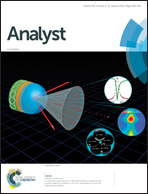A reversible fluorescent probe based on C![[double bond, length as m-dash]](https://www.rsc.org/images/entities/char_e001.gif) N isomerization for the selective detection of formaldehyde in living cells and in vivo†
N isomerization for the selective detection of formaldehyde in living cells and in vivo†
Abstract
Formaldehyde (FA) is an endogenously produced reactive carbonyl species (RCS) through biological metabolic processes whose concentration is closely related to human health and disease. Noninvasive and real-time detection of FA concentration in organisms is very important for revealing the physiological and pathological functions of FA. Herein, we design and synthesize a reversible fluorescent probe BOD-NH2 for the detection of FA in living cells and in vivo. The probe is composed of two moieties: the BODIPY fluorophore and the primary amino group response unit. The probe undergoes an intracellular aldimine condensation reaction with FA and forms imine (C![[double bond, length as m-dash]](https://www.rsc.org/images/entities/char_e001.gif) N) which will result in C
N) which will result in C![[double bond, length as m-dash]](https://www.rsc.org/images/entities/char_e001.gif) N isomerization and rotation to turn-off the fluorescence of the probe. It is important that the probe can show a reversible response to FA. The probe BOD-NH2 has been successfully applied for detecting and imaging FA in the cytoplasm of living cells. BOD-NH2 is capable of detecting fluctuations in the levels of endogenous and exogenous FA in different types of living cells. The probe can be used to visualize the FA concentration in fresh hippocampus and the probe can further qualitatively evaluate the FA concentrations in ex vivo-dissected organs. Moreover, BOD-NH2 can also be used for imaging in mice. The above applications make our new probe a potential chemical tool for the study of physiological and pathological functions of FA in cells and in vivo.
N isomerization and rotation to turn-off the fluorescence of the probe. It is important that the probe can show a reversible response to FA. The probe BOD-NH2 has been successfully applied for detecting and imaging FA in the cytoplasm of living cells. BOD-NH2 is capable of detecting fluctuations in the levels of endogenous and exogenous FA in different types of living cells. The probe can be used to visualize the FA concentration in fresh hippocampus and the probe can further qualitatively evaluate the FA concentrations in ex vivo-dissected organs. Moreover, BOD-NH2 can also be used for imaging in mice. The above applications make our new probe a potential chemical tool for the study of physiological and pathological functions of FA in cells and in vivo.
![Graphical abstract: A reversible fluorescent probe based on C [[double bond, length as m-dash]] N isomerization for the selective detection of formaldehyde in living cells and in vivo](/en/Image/Get?imageInfo.ImageType=GA&imageInfo.ImageIdentifier.ManuscriptID=C7AN01488K&imageInfo.ImageIdentifier.Year=2018)
- This article is part of the themed collections: Analyst Recent HOT articles and Recent analytical chemistry science from China


 Please wait while we load your content...
Please wait while we load your content...
![[double bond, length as m-dash]](https://www.rsc.org/images/entities/h2_char_e001.gif) N isomerization for the selective detection of formaldehyde in living cells and in vivo
N isomerization for the selective detection of formaldehyde in living cells and in vivo